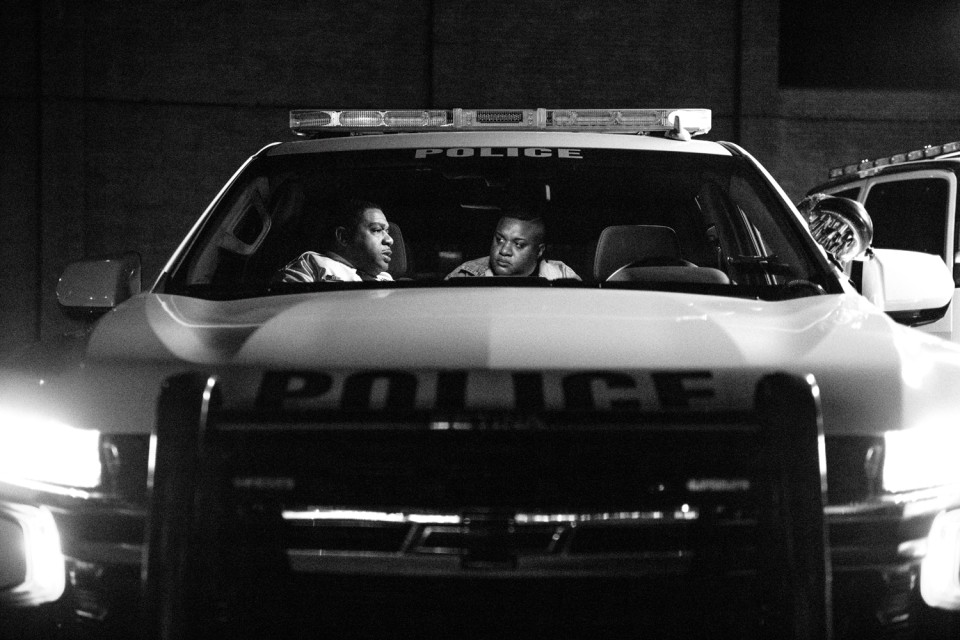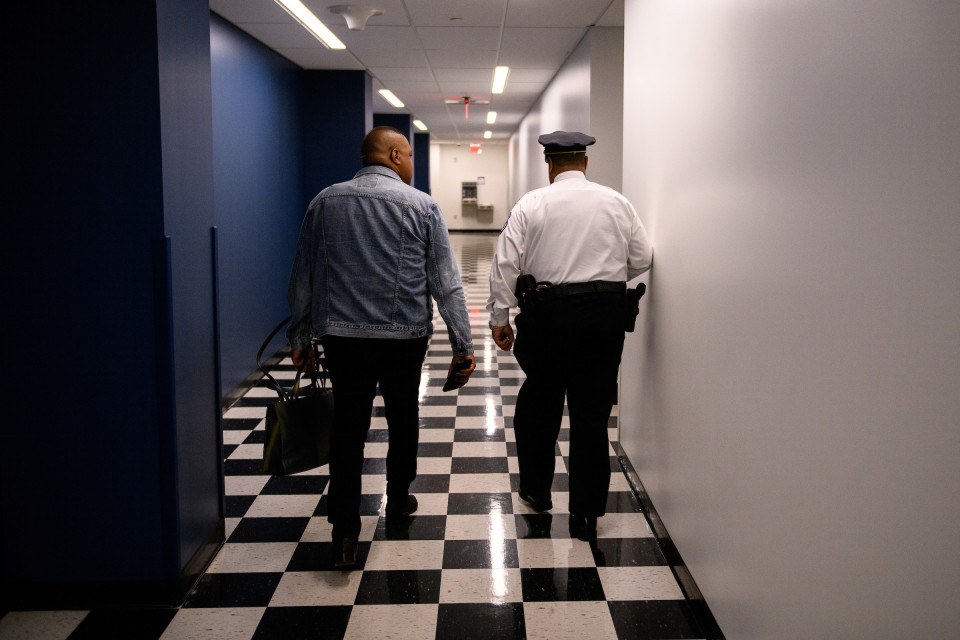My Ride-Along With the Police Commissioner
No issue is more critical to the future of Philadelphia than public safety. So we spent an evening in a squad car with interim commish John Stanford Jr., the man who thinks he’s got the best plan to secure our streets.

From left: Interim police commissioner John Stanford Jr. and the author / Photography by Kriston Jae Bethel
Anyone who’s read my work here over the years knows where I stand on law enforcement: Like so many members of the Black community in America, I have a deep distrust of police. Some of that is inherited. Some of it’s earned.
On a national level, the 2020 extrajudicial murder of George Floyd laid bare the way that many Black and brown communities have long viewed the police — as a systemic vessel of terror and danger, one that’s fed a mass-incarceration crisis disproportionately afflicting those communities. I’ve been the victim of unfair targeting and intimidation by the Philadelphia police department that unfortunately confirmed my distrust in the institution.
So when I was offered the opportunity to do a ride-along with John Stanford Jr., the veteran cop serving as interim commissioner of the beleaguered department, every fiber of my being told me to decline.
But I didn’t. This moment — Philadelphia is preparing for a new mayor as its twin epidemics of gun violence and opioids continue to make national headlines — feels like an inflection point, a chance to bring new energy and ideas to issues that have claimed so many lives and that threaten the sense of progress in the city over the past three decades.
Public safety was the number one issue in the recent mayoral race, for a couple of reasons. First, the predominantly Black and brown neighborhoods that are most impacted by gun violence seem desperate for a different approach. Mayor-elect Cherelle Parker won on a platform that pushed a more traditional view of public safety, and that message notably reverberated in those neighborhoods.
Second, the perception that the city is “lawless” (in the parlance of certain pundits) threatens its viability — from tourism to business investment to regional morale.
Stanford demonstrated refreshing leadership during his challenging first month as interim commissioner, stepping in for the departed Danielle Outlaw, who in September left after three and a half turbulent years for a job with the Port Authority of New York and New Jersey. Stanford certainly looked the part as he dealt with a series of difficult situations. He was strong and forceful in the face of looting in Center City after a judge dropped charges against officer Mark Dial in the shooting death of Eddie Irizarry. (Those charges were later reinstated.) He dealt with the high-profile murder of a journalist; a viral, violent encounter between a dirt-biker and a mother in a car; and the on-duty killing of a veteran officer.
The next leader of the Philadelphia police department will have a pretty big role in Philly’s immediate future, and I wasn’t about to pass up an opportunity to pose my questions to a leading contender.
So on Wednesday, October 25th — two days after the funeral of veteran officer Richard Mendez and the day before reports that longtime FOP leader John McNesby would be resigning for a new role — I went on a late-night ride-along with Stanford, in an attempt to understand why he would want to assume the city’s most consequential non-elected role, and what people like me, concerned about public safety but wary of policing-as-usual, should expect from him. I never would have imagined myself interviewing a cop in a police car — but desperate times call for different measures.
Around 8:30 p.m., I arrived at police headquarters at 400 North Broad Street. I was sent straight to the commissioner’s conference room, where I signed a consent form and donned a bulletproof vest.
I was nervous. The last time I was in the halls of law enforcement was December 18th, 2017, when I was interrogated by the department’s counterterrorism unit about a Facebook comment I’d made. I was 26 and the LGBTQ editor of this publication, covering racial discrimination and bias within the community. An older white man who was affiliated with the Mummers contacted the police about a post I’d made that criticized his controversial performance group. Within days of making the post, I was called in for questioning for more than an hour. Exercising my right to free speech didn’t lead to my arrest, but the experience affirmed my distrust of the institution.
On October’s visit, when interim commissioner Stanford entered the room, I kept a stiff upper lip. He’s a moderately stern, broadly built officer who’s decorated with all the insignia, stripes and bars you’d expect of someone with 22 years of distinguished service. We shook hands, and two police staffers accompanied us and a Philly Mag photographer to a marked police SUV.

Writer Ernest Owens walks down a hallway while speaking with John Stanford Jr., interim Police Commissioner for the Philadelphia Police Department, at PPD headquarters in Philadelphia on October 25, 2023.
For much of the evening, I would get to ask the acting commissioner all the questions I’ve had about the state of law enforcement as we rode through the 22nd police district in North Philly — one of the most dangerous sections of the city. Along with nearby districts 24, 25 and 39, it represents 43 percent of all the reported crime in Philly.
It was obvious from the beginning of our time together that Stanford, a 44-year-old Black man who was born and raised in West Oak Lane, had a lot on his mind and would be forthcoming. I started with an easy question: why he originally wanted to be a police officer. Instead of the standard points you often hear about “maintaining law and order,” Stanford invoked family dynamics. “I think it’s more about being the fixer and realizing: In my personal life, I do the same,” he said. “With family, you try to be the fixer for things. … As I’ve gotten more and more involved in this, I think it’s more about really wanting to be that fixer for everybody.”
A fixer is exactly what the police department desperately needs. Outlaw’s turbulent tenure was punctuated by moments of high-profile failure that led to a steady erosion of trust and faith in the force. But even before Outlaw, policing in the city faced many of the same challenges seen in other parts of the country, as new ideas about criminal justice reform clashed with the hidebound nature of the Thin Blue Line. Stanford certainly seems to have the experience necessary to get under the hood and make some repairs. He has a bachelor’s degree in criminal justice with a minor in business from Penn State. And since the beginning of the century, he’s worked his way up through the ranks of the PPD, having previously served as a county probation/parole officer.
But “fixing” a police department is no easy task — and can mean different things to different constituencies. It’s been the very flashpoint in the debates over criminal justice reform.
When I asked how Stanford would juggle such competing expectations, he spoke about the extreme perceptions of crime in Philly right now and the need to get those perceptions under control. Studies have shown a widespread belief that inner-city crime is rampant and needs to be addressed. Yet during the pandemic, I and many others called for police reform and a dismantling of the system, and some organizers demanded abolition of the police altogether.
Stanford gave me his theory on the nuances of this dynamic.
“There has been so much scrutiny of law enforcement, [with calls for] a hands-off approach. You start to question whether or not people want any type of law enforcement and how much law enforcement,” he said. “Now you see crime starting to shift back up, and there are calls for a stronger law-enforcement presence, a stronger law-enforcement approach.”
No one could accuse mayor-elect Cherelle Parker of being coy about her intentions when it comes to public safety. In campaigning, she was open about trying to re-empower police through reviving stop-and-frisk, and she’s floated the idea of employing the National Guard in Kensington. She was clear that tactics need to be constitutional and non-discriminatory, but an abolitionist she’s not.
Stanford is cut from the same cloth. He’s not a grizzled vet, but his philosophy has strong strains of old-school. If he’s got reform and greater accountability on his agenda, I’d have to do some more digging to find it.
Around the halfway mark of our ride-along, we made a quick stop at the 22nd district police department headquarters. As we pulled in, a minor celebrity walked up to our SUV: Sergeant Philip Cherry, who in October was at the center of an infamous viral video. In it, he was attempting to quell a large melee near Dobbins High School when he was kicked from behind and knocked to the pavement while students jeered. Cherry walked off in disgust, slamming his baton to the ground, and a student slapped him in the head before running off. The young suspects involved in the incident were reportedly arrested for assault and cited for disorderly conduct.
The video of Cherry’s mistreatment sparked the type of commentary you’d expect online and in op-eds: Where are the parents? No respect. LAWLESSNESS. Was that bump into Cherry a coincidence? Probably not. With me, Stanford used the moment to try to draw some parallels.
“When police do something that’s not right, it’s called out,” he declared. “When there is behavior that’s committed by someone in the community against police, all that has to be called out equally. It can’t be just one way or the other, one side or the other.”
I wasn’t having it.
“What do you say in situations like, for example, what happened to Eddie Irizarry?” I asked. (In August, Irizarry was shot to death by officer Mark Dial, who claimed he was acting in self-defense. In September, a judge dismissed the charges; in October, charges were reinstated.) “Whoever did that to Officer Cherry,” I continued, “we know that they will be properly prosecuted; they will be held accountable.”
And yet there remains real doubt over whether Dial will be held accountable for shooting Irizarry to death. There seem to be different laws for people who enforce the law, which is just another type of lawlessness.
Stanford agreed to disagree. The way he sees it, “In situations where police have done things that are questionable and harmful, we don’t see a reciprocal consequence given to a civilian in the same way as police.” We moved on.

As we continued to ride through North Philly, the police radio reported that 20 gunshots had been fired near a street we had just driven down. It was a “damn” moment — one in which everything stopped as we tried to figure out exactly what had happened. How could that much gunfire have erupted near where a marked car had just passed? Would any amount of police deployment have stopped it? There was a pause as the officers in the SUV sought details. For a second, it was unclear whether our ride-along would continue — but things quickly (but cautiously) got back on track. The sudden reality of that announcement jolted us and prompted the next touchy subject: stop-and-frisk.
This infamous practice allows police to detain and search people they reasonably suspect are involved in criminal activity. In practice, it’s been an excuse for police to stop and search people of color. It has been called unconstitutional by criminal justice advocates and was the subject of a class-action suit: In 2010, the ACLU sued Philadelphia over the practice, and in 2011, the sides reached a settlement that required the city to collect and share data on stop-and-frisks, comply with a monitoring system, and implement better training. Mayor Jim Kenney said he supported ending unconstitutional stop-and-frisk, but he never took official action to do so.
Did Stanford believe stop-and-frisk, as it’s been practiced, has been racially biased?
“I couldn’t sit here and argue one way or the other. The only way I would be able to do that is if I knew every stop that was made and why,” Stanford told me. He consistently referred to the practice as a “Terry stop” — named for the 1968 Supreme Court case, Terry v. Ohio, that deemed it constitutional. Cherelle Parker used the term in debates, almost as if to say, “It’s not stop-and-frisk — it’s legal.”
Stanford then pivoted, framing the issue of stop-and-frisk as a matter of better “training,” referencing “tiers” and an “early intervention system” the department is working on to ensure that when officers stop citizens, it’s done constitutionally.
The way I see it, until the disproportionate profiling of Black and brown citizens is addressed, there’s no way progress can be achieved via stop-and-frisks or Terry stops — whatever you want to call them. It’s clear to me where at least one of Stanford’s shortcomings lies: He knows a lot about change, but he’s still beholden to ideas that can make implementing change impossible.
“A mayor and a commissioner want the same thing. You want to see this city thrive. So if the city is safe and people feel safe, then the city thrives financially.” — John Stanford Jr., interim PPD commissioner
With a few minutes left in our ride-along, I needed to ask him the burning question on my mind: Do you want to be the permanent police commissioner of Philadelphia?
“Yes. I have a love for what we do,” Stanford replied. “I have a love for this department; I have a love for this city. I absolutely would be honored to continue to be in a position of leading this department.”
For that to happen, Parker would have to appoint him. Stanford says he hasn’t previously worked with her in any capacity.
“At the end of the day, you want the same thing, which is success,” Stanford said of how he envisions the relationship between commissioner and mayor. “You want the same things, which is safety for the city; you want to see this city thrive. … So if the city is safe and people feel safe, then the city thrives financially.”
Stanford’s predecessors, Outlaw and Richard Ross, left the position under clouds. After several years of backlash and scrutiny of Outlaw’s performance in the role (notably, tear-gassing protesters on I-676 and the department’s sloppy handling of initial details regarding Irizarry’s case), she left for a quieter role as deputy security chief at the Port Authority of New York and New Jersey. Her predecessor, Ross, resigned abruptly in 2019 after being accused of retaliating against a female staffer he’d previously had an affair with.
When I asked Stanford how he would differ from previous leaders in the role, he said he was “not one to compare myself to any one specific person.” But he didn’t hesitate to note his strengths.
“I’ve come through the ranks here,” he said. “I’ve worked hard for the opportunities, and any opportunity that I’ve been afforded, I never take it for granted. I’ve worked hard in every space that I’ve been in. So I think that the one thing I’m going to always have is the knowledge and experience, but also, I’m going to work hard.”
With that approach, perhaps Stanford is the right person for the job, at least for now. In a time of public outcry, he has a reflective demeanor that doesn’t give way to fear or impulsiveness — a quality we need from our leaders across the board. He has deep experience and seems to believe in evidence-based approaches, or at least in doing what has gotten results. Is he open to new approaches and not just the tried-and-true? Time may tell.
As we made our way back to the station, the early unease I’d felt had been tempered. The evening was a roller coaster of thoughts and feelings that I’m still reflecting on. Spending time with Stanford, and being on patrol, confirmed my belief that there’s no such thing as an “ideal” police commissioner, given our flawed system of criminal justice. But clearly, there have been better and worse officers in the role. Former commissioner Charles Ramsey, who became an icon of police reform for his work with President Obama, is definitely held in higher esteem these days than the infamous Frank Rizzo. With his years of experience and discipline, Stanford at least seems more like the former than the latter.
Published as “Riding With the Commish” in the December 2023/January 2024 issue of Philadelphia magazine.


